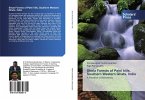Kerala's Green Invaders: A Study of Invasive Plant Species in Kerala, explores the ecological impact and management strategies concerning ten major invasive plant species prevalent in Kerala. Among these, Camonea vitifolia, Chromolaena odorata, Hyptis suaveolens, Lantana camara, Mikania micrantha, Mimosa diplotricha Sauvalle, Mucuna bracteata, Parthenium hysterophorus, Pontederia crassipes, and Senna spectabilis, are identified as particularly aggressive invaders, altering ecosystems and threatening native flora and fauna. The study analyzes the spread, distribution, and ecological implications of these invasive species, shedding light on their mechanisms of proliferation and the challenges they pose to biodiversity conservation efforts in Kerala. Additionally, the study explores various control and management approaches, including mechanical, chemical, and biological methods, as well as community-based initiatives and policy interventions. Understanding the dynamics of these invasive species is crucial for developing effective management strategies to mitigate their negative impacts on Kerala's ecosystems, safeguarding its natural heritage for future generations.
Bitte wählen Sie Ihr Anliegen aus.
Rechnungen
Retourenschein anfordern
Bestellstatus
Storno








